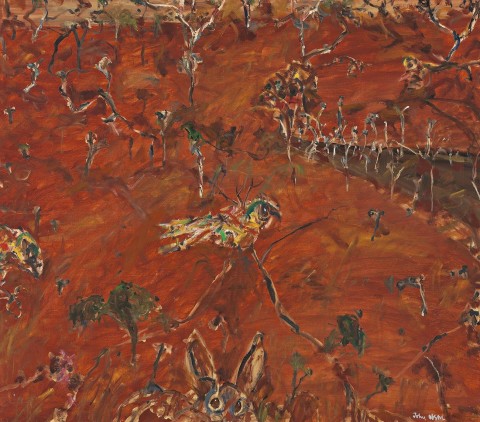RABBIT WARREN – RYDAL, 1997
JOHN OLSEN
oil on canvas
107.0 x 121.0 cm
signed lower right: John Olsen
Private collection, Melbourne, acquired directly from the artist in 1998
Grishin, S., Accounting for Taste: The Lowensteins Arts Management Collection, Macmillan Art Publishing, Melbourne, 2013, p. 190 (illus.)
‘I am in the landscape, and the landscape is in me, that’s the experience that drives the line. Once I get a central rhythm going, it propels itself. I feel a rapport and one thing suggests another, asks a question, sees a connection just like a poetical form. It’s telling me, push me this way, more colour here … it’s all about filling space, and leaving space, the yin and yang, to make it work.1
With a vast and varied oeuvre spanning more than seven decades, John Olsen has quite deservedly been hailed Australia’s greatest living artist. From the pulsating, larrikin energy of his You Beaut Country series, to the quieter, more metaphysical paintings inspired by his expeditions to Lake Eyre, or the exquisitely lyrical works immortalising his halcyon days in Clarendon, Olsen’s unique interpretations of the natural environment in its manifold moods have become indelibly etched on the national psyche, revolutionising the way in which we now perceive the Australian landscape. Indeed, where artistic predecessors such as Russell Drysdale and Sidney Nolan had presented visions of a parched, inhospitable land, where figures stand as sentinels in the wilderness, Olsen instead highlights the abundant activity and incident within this sprawling terrain, inviting the viewer to experience his sheer wonderment at the redemptive, life-affirming properties of mother nature: ‘The urge for life is a staggering thing and we just ought to take notice … There is such fecundity in this universe’.2
In March of 1990, John Olsen and his wife Katherine moved to Chapel House at Rydal, near Bathurst in the Central Tablelands of New South Wales where, beyond the quaint town with its population of only eighty people, the artist discovered a surfeit of native flora and fauna in a resplendent setting of rolling hills, sweeping valleys and teeming waterways. Often painting en plein air during this period, Olsen not surprisingly gleaned enormous inspiration and comfort in such habitat, as lyrically expressed in both his paintings and written recollections of the region in all its moods. ‘… March 20, Mists foretelling Autumn are curling down from Mount Lambie, a touch of gold is in the willows. Ash trees are bright red. No significant rain since late October, the grass is cackling straw’.3 And elsewhere, ‘… The landscape rolls with rounded hills – the trees entwine and chatter with each other, pausing only to take note of a large galah’.4
With its raw beauty, distinctive playful brushstrokes and earthy palette of terracotta and ochre hues, Rabbit Warren, Rydal, 1997 offers a particularly eloquent example of Olsen’s work from this inspired period of contented rural dwelling – a chapter which also featured the magnificent Summer at Rydal, 1997 (a finalist in the Art Gallery of New South Wales’ prestigious Wynne Prize) and the diptych Spring at Rydal, 1992. Attesting to the artist’s remarkable ability to capture the spirit of the Australian landscape – to express ‘a certain mystical throbbing throughout nature’ – the painting resonates with a vitalistic energy, betraying a sense of not only keen observation, but of joyful celebration derived from a lifetime dedicated to physical and spiritual immersion in the landscape. For ultimately, whether amidst the undulating foothills of the Blue Mountains (as witnessed here) or the drought-ravaged plains of the Kimberley Desert, the Australian landscape afforded Olsen far more than mere topographical phenomena to be accurately recorded. More fundamentally, the experience was the catalyst for a myriad of ideas and metaphorical connections that reaffirmed his spirituality and enduring belief in the total interconnectedness of all living forms; as art historian Deborah Hart elucidates,
‘… his sense of place has always been about a geography of mind, experience and poetic imagination – continually transforming and enlivening the ways in which we conceive of the connections between the world around and within ourselves’.5
1. Hawley, J., ‘The Masterly Mr Squiggle’, Good Weekend, Sydney Morning Herald, Sydney, 2 September 2006
2. Olsen quoted in Hart, D., John Olsen, Craftsman House, Sydney, 1991, p. 123
3. Olsen, J., Drawn from Life, Duffy and Snellgrove, Sydney, 1997, p. 282
4. Olsen quoted in Hart, op. cit., p. 238
5. Hart, D., Australian Painters of the Twentieth Century, The Beagle Press, Sydney, 2000
VERONICA ANGELATOS
